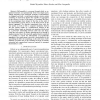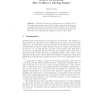26354 search results - page 56 / 5271 » How we refactor, and how we know it |
ICWL
2007
Springer
14 years 3 months ago
2007
Springer
In this paper we present the European project Open Dance and in particular our contribution to the 3D simulation of folk dances and their presentation on the web. Our aim is to pro...
ICRA
2008
IEEE
14 years 3 months ago
2008
IEEE
Abstract— Self-assembly is a process through which an organized structure can spontaneously form from simple parts. Taking inspiration from biological examples of self-assembly, ...
ICALP
2010
Springer
13 years 11 months ago
2010
Springer
Gossip protocols, also known as epidemic dissemination schemes, are becoming increasingly popular in distributed systems. Yet, it has remained a partially open question to determin...
ENTCS
2011
13 years 4 months ago
2011
We preliminarily recap what is meant by complexity and non-Turing computation, by way of explanation of our title, ‘Computational Complexity in Non-Turing Models of Computationâ...
ESA
2003
Springer
14 years 2 months ago
2003
Springer
A kinetic dictionary is a data structure for storing a set S of continuously moving points on the real line, such that at any time we can quickly determine for a given query point ...


